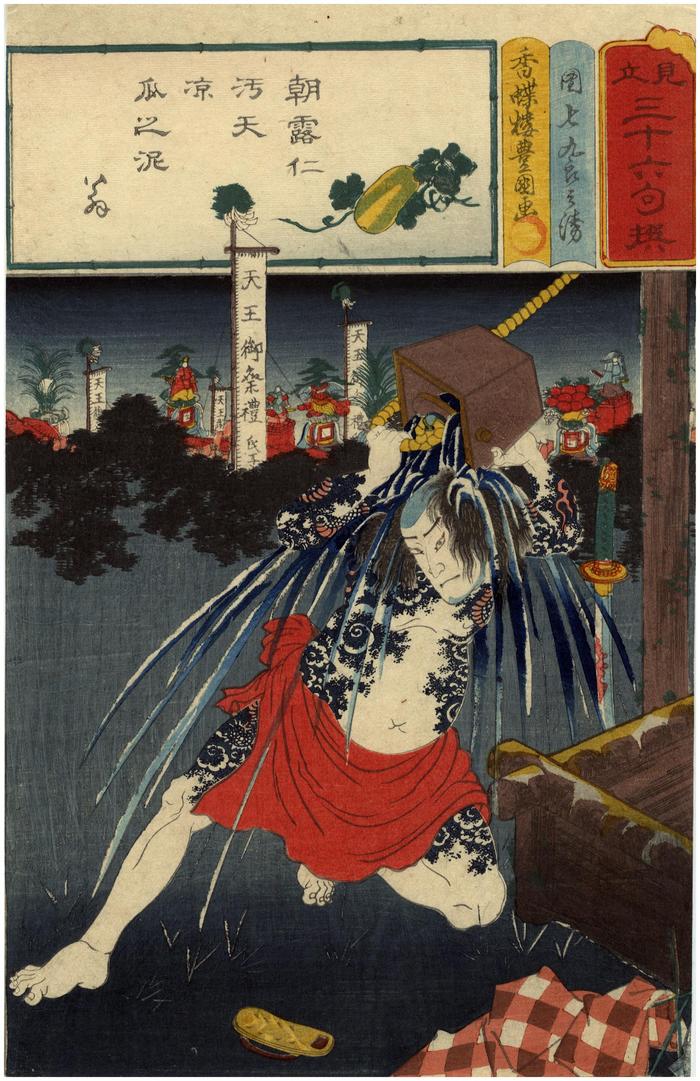Utagawa Kunisada (歌川国貞) / Toyokuni III (三代豊国)
(artist 1786 – 01/12/1865)
Miyagi Gengyo (宮城玄魚)
(artist 1817 – 1880)
Nakamura Fukusuke I (中村福助) as Danshichi Kurobei (團七九郎兵衛) from the series Matches for Thirty-six Selected Poems (Mitate sanjūrokkusen - 見立三十六句撰) - the inset at the upper left is by Miyagi Gengyo
12/1857
8.75 in x 13.5 in (Overall dimensions) Japanese color woodblock print
Signature: Kōchōrō Toyokuni ga
香蝶楼豊国画
Artist's seal: toshidama
Museum of Fine Arts, Boston
Waseda University
National Diet Library
Museum of Fine Arts, Houston
Tokyo Metropolitan Library
Ritsumeikan University
Victoria and Albert Museum This print is trimmed to the image. If it wasn't it would show the publisher on the left margin. The publisher was Sagamiya Tōkichi (Marks 435 - seal 24-009), aka Aito. Its seal can be seen on the example in Boston.
****
Illustrated in color in Andon 87, 2009, on page 118. It says: "The actor Nakamura Fukusuke (1ater named Nakamura Shikan IV) is surrounded by all the paraphernalia that connect him to the role of Danshichi: the sandal that his father-in-law beat him with, the brown-and-white chequered coat, the wooden well frame, the bucket of water he pours over his head, his bloody sword, and in the background, the festive floats of the Summer Festival Apart from wearing his red loincloth, he is decorated with a fu1l body tattoo showing dragons among clouds coiling down to his wrists and upper legs.
The poem in the upper cartouche reads (translation Blyth):
Asa-tsuyu niThe poem metaphorically refers to someone who seems ordinary (smirched with earthly mud) but actually has a pureness of spirit that produces a surprising feeling of freshness."
Yogorete suzushi
Uri no doro
In the morning dew
dirty, but fresh,
the muddy melon.
****
Although the inset image at the top of this print is not signed it is by Miyagi Gengyo. Other insets in this series, which are consistent in their design, are signed by that artist.
****
The text reads:
朝露仁汚天涼瓜之泥
****
The series
"In 1856, two years after the American Commodore Perry had forced Japan to open its harbours to foreign countries, the 71-year-old print artist Kunisada (1786-7864) had a meeting with three publishers to discuss the production of a new series of woodblock prints. They must have had a premonition that Japan was entering a new era, but continued business as usual and decided to issue another traditional series of woodblock prints, titled Comparisons to a selection of thirty-six verses (Mitate sanjurokkusen). Each print would show a poem in combination with a scene from the Kabuki stage. The term mitate (comparison, parody, allusion) in the title suggests the prints of the series also challenged buyers to find connections between the poems and the Kabuki scenes. Most likely the series aimed at Kabuki devotees and those interested in poetry. By the mid-19th century literacy among Japan's townspeople was very high. Books were widely available and membership of poetry clubs enjoyed unprecedented popularity. Anthologies with hundreds of amateur verses, often with humorous or parodic varieties of classical Japanese poems, were published in ever greater numbers."
Quoted from: 'Surprise comparisons in Kunisada's print series Mitate sanjūrokkusen' in Andon 96 by Henk Herwig, Jos Vos and Paul Griffith, p. 37.
Sagamiya Tōkichi (相模屋藤吉) (publisher)
actor prints (yakusha-e - 役者絵) (genre)
Danshichi Kurobei (団七九郎兵衛) (role)
mitate-e (見立て絵) (genre)
Nakamura Fukusuke I (初代中村福助: 3/1839 to 6/1860) (actor)
Tattoo (genre)
